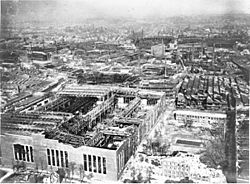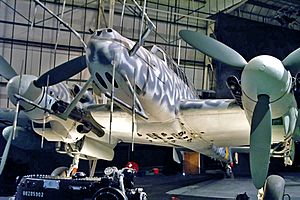Battle of the Ruhr facts for kids
Quick facts for kids Battle of the Ruhr |
|||||||
|---|---|---|---|---|---|---|---|
| Part of Strategic bombing during World War II | |||||||
 The Krupp factory at Essen, 1945 |
|||||||
|
|||||||
| Belligerents | |||||||
| Commanders and leaders | |||||||
| Charles Portal Arthur Harris |
Hermann Göring Josef Kammhuber |
||||||
| Strength | |||||||
| Bomber Command March: 380 heavy, 160 medium bombers July: 800 bombers |
radar anti-aircraft guns day and night fighters |
||||||
| Casualties and losses | |||||||
| c. 5,000 aircrew 675 aircraft lost 2,126 aircraft damaged USAAF: 16 B-17s Bomber Command 4.7 per cent (43 attacks, 18,506 sorties) |
21,000 killed | ||||||
The Battle of the Ruhr was a major air campaign during World War II. It took place from March to July 1943. The RAF Bomber Command attacked the Ruhr Area in Nazi Germany. This region was super important for Germany's war effort. It had many factories that made steel, weapons, and even special fuel.
The British aimed for 26 key targets, including the famous Krupp weapons factory in Essen. They also bombed cities like Cologne, which were close to the Ruhr industrial heartland. The Ruhr region was always hard to bomb because of its strong defenses and the thick smog from all the factories. German defenses included anti-aircraft guns, searchlights, and night fighters. They even built fake factories to trick the bombers! Sometimes, the RAF also attacked cities outside the Ruhr to spread out Germany's defenses.
Contents
Why the Ruhr was a Target
The Ruhr region was like Germany's industrial powerhouse. It produced most of Germany's coal, iron, and steel. These materials were vital for making tanks, planes, and other war supplies. The area was packed with factories and towns, making it a huge target for bombing.
RAF Bomber Command's Challenges
In 1942, the RAF faced big challenges with night bombing. It was hard to find targets in the dark and through the smog. New navigation tools like Gee helped, but they weren't always accurate and could be jammed by the Germans.
The Pathfinder Force (PFF) was created to help. These special planes would fly ahead and mark targets for the main bomber force. But without accurate tools, their job was very tough. German night fighters were also getting better, making bombing missions very dangerous.
New Tools for Bombing
By 1943, the RAF got new, better equipment:
- Gee: This system used radio signals from England to help navigators find their position. It was good for getting back home safely, but less accurate for bombing, especially when Germans jammed the signals.
- Oboe: This was a super accurate system for blind bombing. Two ground stations in England guided a fast Mosquito bomber to the target using radar. It was very precise, but only one plane could use it at a time.
- Target Indicator (TI) Bombs: These bombs released colored flares or smoke to mark the target for other bombers. They were a huge success and made pathfinding much more effective.
- H2S: This was a radar system on the plane itself that showed a map of the ground below. It helped navigators see rivers, coastlines, and towns, even in bad weather. However, it could also be detected by German radar, making the bombers vulnerable.
Germany's Air Defenses
Germany had been preparing for Allied bombing since 1940. They built a strong defense system, especially around the Ruhr.
The Kammhuber Line
Colonel Josef Kammhuber created a defense system called the Kammhuber Line. It was a long belt of radar stations, searchlights, and night fighter zones.
- Freya radar gave early warnings of incoming planes.
- Würzburg radar was more accurate and guided anti-aircraft guns and night fighters.
- Helle Nachtjagd (Illuminated Night Fighting) used searchlights to light up bombers for night fighters to attack.
- Dunkel Nachtjagd (Dark Nightfighting) zones were along the coast without searchlights.
By 1942, the German night fighter force grew stronger. They used Lichtenstein radar on their planes, which helped them find bombers in the dark. The Himmelbett system allowed one night fighter to be guided to a bomber in each zone.
Germany also had many anti-aircraft guns (called FlaK). By July 1943, there were over 1,000 large FlaK guns and 1,500 smaller ones in the Ruhr. These guns needed hundreds of thousands of people to operate them.
The Battle Begins
The Battle of the Ruhr started on March 5, 1943, with a large raid on Essen. The RAF used a mix of bombs, including many incendiaries (fire bombs). The goal was to cause widespread destruction and disrupt Germany's war production.
The table below gives a quick overview of some of the major raids during the battle:
| Date | Target | Impact |
|---|---|---|
| 5/6 March 1943 | Essen | First major raid. Significant damage to the city center and Krupp works. |
| 12/13 March 1943 | Essen | More damage to Essen, including many homes. |
| 29/30 March 1943 | Bochum | Bombs scattered due to cloud cover, but some damage. |
| 3/4 April 1943 | Essen | Good bombing accuracy, causing more destruction in Essen. |
| 4/5 May 1943 | Dortmund | Severe damage to central and northern districts, including steel foundries. |
| 23/24 May 1943 | Dortmund | Clear weather allowed accurate bombing, hitting the city center and Hoesch steelworks. |
| 29/30 May 1943 | Wuppertal (Barmen) | Devastating firestorm, burning down nearly 80% of the town. Many factories and homes destroyed. |
| 11/12 June 1943 | Düsseldorf | Large fires in the city center, stopping production in many war-related factories. |
| 12/13 June 1943 | Bochum | Accurate bombing destroyed a large area of the city center. |
| 21/22 June 1943 | Krefeld | Nearly perfect marking led to massive fires, destroying almost half the city center. |
| 22 June 1943 | Hüls | US daylight raid on a synthetic rubber plant, causing it to close for a month. |
| 22/23 June 1943 | Mülheim | Many fires, severe damage to the city center and nearby areas. |
| 24/25 June 1943 | Wuppertal (Elberfeld) | Another accurate attack on Wuppertal, destroying many industrial buildings and homes. |
| 28/29 June 1943 | Cologne | Concentrated attack, causing widespread destruction and making many people homeless. |
| 3/4 July 1943 | Cologne | Another heavy attack, causing more damage and casualties. |
| 8/9 July 1943 | Cologne | Continued bombing made over 350,000 people homeless in Cologne over a week. |
| 25/26 July 1943 | Essen | Severe damage to industrial areas, including the Krupp works, which suffered its worst damage of the war. |
| 30/31 July 1943 | Remscheid | Very accurate bombing destroyed 83% of the town, causing huge losses in industrial production. |
The Dambusters Raid
A very famous part of the Battle of the Ruhr was Operation Chastise, also known as the Dambusters raid, on May 16/17, 1943. A special RAF squadron, No. 617 Squadron, was formed to attack dams in the Ruhr region. They used unique "bouncing bombs" to try and destroy the dams.
The Möhne and Eder Dams were successfully breached. The Möhne Dam was a key water supplier for the Ruhr, and its destruction caused flooding, power cuts, and water shortages. This temporarily disrupted industrial production. Sadly, this raid also led to many civilian casualties, including workers who were forced to work in the area.
After the Battle
The Battle of the Ruhr officially ended on July 31, 1943. During this period, the RAF flew over 18,500 bombing missions. They lost 872 aircraft and had over 2,100 damaged. Around 6,000 aircrew members were killed or injured.
The bombing caused significant damage to German cities and industries. While it didn't completely stop Germany's war production, it put a lot of pressure on their resources and forced them to divert efforts to defense and repairs. The battle showed the growing power of Allied air forces and the challenges Germany faced in defending its homeland.
Images for kids













